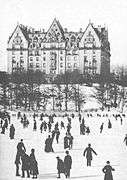Edward Severin Clark
Edward Severin Clark (July 6, 1870 – September 19, 1933), was an American businessman, and the owner of the New York City apartment building The Dakota.
He was the eldest of the four sons of Alfred Corning Clark and Elizabeth Scriven. The brothers grew up in New York City and Cooperstown, New York.[1] His grandfather, Edward Cabot Clark, was Isaac Singer's partner in the Singer Sewing Machine Company, and built Manhattan apartment buildings, including The Dakota. The grandfather died during construction of The Dakota and bequeathed it to Edward, his 12-year-old grandson and namesake.[2]
Edward and his brother, Stephen Carlton Clark, built a number of large buildings in Cooperstown, including the Otesaga Hotel (1909), the Mary Imogene Bassett Hospital (1918), and the Alfred Corning Clark Gymnasium (1930).[3] "Fenimore House," the mansion he built for himself overlooking Otsego Lake, is now the Fenimore Art Museum. His former dairy farm is now the Farmers' Museum.[4]
Another brother, Robert Sterling Clark, founded the Sterling and Francine Clark Art Institute.
Edward never married or had children. He donated the sculpture The Great God Pan (1899) by George Grey Barnard to Columbia University in 1907.[5]
Gallery
.tiff.jpg) "Fernleigh" (1869) Edward Cabot Clark residence, Copperstown, New York
"Fernleigh" (1869) Edward Cabot Clark residence, Copperstown, New York The Dakota, from Central Park Lake (1880s)
The Dakota, from Central Park Lake (1880s)- The Great God Pan (1899) by George Grey Barnard, Columbia University
 "Fenimore House" (1932), now Fenimore Art Museum, Cooperstown, New York
"Fenimore House" (1932), now Fenimore Art Museum, Cooperstown, New York Farmers' Museum, Cooperstown, New York
Farmers' Museum, Cooperstown, New York
References
- ↑ Nicholas Fox Weber. The Clarks of Cooperstown: Their Singer Sewing Machine Fortune, Their Great and Influential Art Collections, Their Forty-Year Feud. Alfred A. Knopf, (May 8, 2007). ISBN 0307263479
- ↑ Stephen Birmingham, Life at The Dakota: New York's Most Unusual Address, (Open Road Media, 2015).
- ↑ (no author), The History of the Clark Sports Center; The First 125 Years, (PDF) from All Otsego.
- ↑ Henry Naccari, "Baseball Hall of Fame is top draw but hidden treasures can also be found in Cooperstown," North Country News, July 30, 2003.
- ↑ "George Grey Barnard and Pan", from Columbia University Libraries.